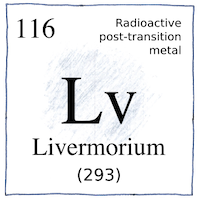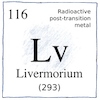Livermorium
Scientists at Dubna tried to synthesize element 116 by bombarding krypton-86 with ions of lead-208, and Victor Ninov fabricated the data to show they had created oganessan-293 which decayed into livermorium-289 . . . Trying again in 2000, they bombarded curium-248 target with ions of calcium-48, and thought they had produced livermorium-296, which decayed to livermorium-292, thence to flerovium-288. However, in 2002 they announced that they their livermorium-296 actually decayed to livermorium-293, thence to flerovium-289.
Atomic number 116
Livermorium is thought to behave like a heavier version of polonium, since livermorium is below polonium in the periodic table. Its behavior is thought be be influenced by relativistic effects, since its electrons must move closer to the speed of light.
Irritativistic effects
Relativistic effects are the differences between actual behaviors and behavioral models that don’t account for the theory of relativity, which gives no help whatsoever in understanding why some people prefer bright lights and some prefer dim.




It seems that more people were involved in the synthesis of livermorium isotopes than the number of isotopes they produced.
This element got its name because the Lawrence Livermore National Laboratory, in Livermore, named after Robert Thomas Livermore, collaborated on the discovery with the Joint Institute for Nuclear Research in Dubna. Dubna wanted to name it moscovium, which name was eventually given to element 115, which scientists from Livermore also collaborated on.
See also in The book of science:
Readings in wikipedia:
Other readings: